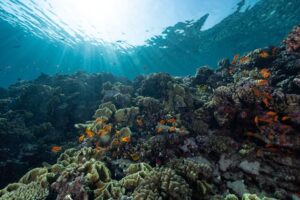Physical Address
23,24,25 & 26, 2nd Floor, Software Technology Park India, Opp: Garware Stadium,MIDC, Chikalthana, Aurangabad, Maharashtra – 431001 India
Physical Address
23,24,25 & 26, 2nd Floor, Software Technology Park India, Opp: Garware Stadium,MIDC, Chikalthana, Aurangabad, Maharashtra – 431001 India

By Aayushi Sharma
The ocean is responsible for producing more than half of the oxygen we inhale. Phytoplankton, which are small marine plants living on the ocean’s surface, perform photosynthesis and generate approximately 50-80% of the Earth’s oxygen. For a long time, people believed the ocean was limitless and unaffected by human actions. Until recently, scientists have recognized the severe damage and ongoing threats to oceans due to anthropogenic activities. Climate change, pollution, overfishing, habitat destruction, invasive species, and various other forms of human exploitation have endangered our oceans.
This World Oceans Day, let us look at 5 technological innovations saving the oceans:
The Seabin Project is a cleantech startup with a mission to address the global issue of ocean plastic pollution and enhance ocean conservation efforts. Their primary commercial product, the Seabin, is a floating garbage bin designed to intercept trash, oil, fuel, and detergents from the water.
Key Features of the Seabin
Impact and Effectiveness
The Seabin Project has demonstrated a significant impact in reducing water pollution. Each Seabin can collect around 1.5 kg of debris per day, which totals approximately half a ton of waste per year per unit. This not only helps in cleaning the water but also raises awareness about the extent of pollution in our oceans.
2. Hydrophobic Sponges
Hydrophobic sponges are an innovative solution for cleaning up oil spills in aquatic environments. These specially designed sponges have unique properties that allow them to repel water while selectively absorbing oil. This makes them highly effective in mitigating the environmental impact of oil spills without harming marine life.
Key Features and Benefits
The image shows a hydrophobic sponge. Credit: Northwestern University
3. 3D Printed Coral Reefs
3D-printed coral reefs represent an innovative approach to marine conservation and habitat restoration. This technology involves creating artificial reef structures that closely mimic the complex architecture of natural coral reefs, providing a habitat for marine life and helping to restore damaged ecosystems.
Key Features and Benefits
Credit: NOAA
4. Biorock Technology
Biorock Technology is a groundbreaking approach to marine ecosystem restoration, using low-voltage electrical currents to enhance the growth of limestone structures underwater. These structures act as substrates for coral and other marine organisms, promoting reef restoration and biodiversity.
Key Features and Benefits:
5. Bycatch reduction
Bycatch refers to non-targeted species caught during fishing. Fisheries bycatch has been identified as a primary driver of population declines in several species of marine mega-fauna
This will ensure the long-term sustainability of fisheries resources, preserve biodiversity, and protect sea turtles from unintentional mortality related to shrimp trawling. To ensure the long-term sustainability of fishery resources, protect biodiversity, and prevent accidental mortality of sea turtles linked to shrimp trawling, it’s essential to legally enforce the adoption of Bycatch Reduction Devices and Turtle Excluder Devices that best suit the specific regional fishery conditions. This should occur following meticulous scientific evaluation and commercial trials.
References:
https://new.nsf.gov/news/smart-sponge-could-clean-oil-spills
https://www.researchgate.net/publication/280029680_Bycatch_reduction_technologies
https://www.engineering.com/story/coral-relief-how-3d-printing-is-reviving-the-oceans-key-ecosystems
Banner Image Source:
Photo by Saad https://www.pexels.com/photo/underwater-view-of-coral-reef-and-flock-of-little-fish-13010769/
Seabin Image Source: https://rewards4earth.org/seabins/?gad_source=1&gclid=CjwKCAjw34qzBhBmEiwAOUQcF3RWAd8wFgUrDOpXWAnYOUzxDik234UQLtABBlZFqXH4qOBfUoUXehoCOoAQAvD_BwE